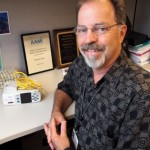The key to MDI is exactly what you’d expect: communication.
By Chris Hayhurst
Ask Scot Copeland where medical device integration (MDI) ranks on his list of concerns as a biomed, and he doesn’t mince words: “It’s right at the top, without a doubt.” The challenge, explains the clinical systems specialist with Scripps/Mercy Hospital, Chula Vista, Calif, has little to do with the front-end mechanics of making the connections that let systems talk. “We can take any device, put it on the network, give it the right port numbers, and have it send its information somewhere.” That part is easy, he says: “We’ve got it figured out.” In Copeland’s experience the bigger issue is what happens next. “That technology still needs to be managed for workflow, for safety, and for effectiveness, but now it spans an entire IT network,” he says. “And that’s a utility that we basically have no control over.”
The obvious solution—close collaboration between IT and biomed—is not as simple as it sounds, Copeland adds. At Scripps/Mercy, for example, on an IT staff of 100, “there’s only one guy … who really understands our use case and our sensitivities and gets what our issues are.” Similarly, among the facility’s nearly 40 biomeds, only six, including Copeland, have experience and training in IT. Copeland describes the resulting lack of understanding between the two camps, and between them and their various outside vendors like device manufacturers and IT security firms, as “acute.”
The hospital recently brought in an IT security company “to run an internal vulnerability scan,” Copeland recalls. “They wound up crashing our monitoring systems several times before we figured out what was going on.” The vendor claimed to have experience testing networks in medical environments, but it was clear they “had no idea how our medical devices would react,” Copeland says.
Many manufacturers, meanwhile, seem to ignore the fact that every hospital’s infrastructure and network are different, Copeland says. “So they sell their device and then say, ‘OK, this is the protocol and this is what it does, put it on your network and fly and be free.’ Well, we can do that, but what about that vulnerability testing? What about supporting it for security? What kind of network constraints does it have? Does it have streaming data that needs to have a certain pipeline?” Medical device makers have legitimate reasons to ignore questions like these, Copeland admits, but that doesn’t make things easier. “I get it—the support isn’t there because they don’t know how their device will work on somebody else’s infrastructure.” If things go awry, he says, “they don’t want to be held responsible.”
A Matter of Governance
That lack of cooperation among the various stakeholders in device integration—intentional or not—is something Tim Gee, principal, Medical Connectivity Consulting, Beaverton, Ore, knows well. “Inadequate governance of medical device systems is a huge issue,” says Gee. (He defines a medical device system as one or more medical devices connected via a network to “various components, servers, and applications.”)
The traditional focus for biomeds and technology management is on the particular needs of standalone equipment, he notes, including device-specific safety checks, preventive maintenance, and recalibration. “So when you look at the policies and procedures in biomed departments, which in my experience are well written and robust, that’s what they cover—the requirements of the embedded-system device.”
The problem is that for things like patient monitoring systems, smart infusion pumps, or a growing number of other medical devices, bedside hardware is just the beginning. Other elements such as networks, servers, and associated software are all important parts of the whole. “So when your hospital IT and biomed departments start playing King Solomon and basically split the baby in half—you take this and I’ll take that—well, who’s looking at the big picture?” From a formal policy-and-procedure standpoint, Gee says, “the answer is no one.”
Thus far, according to Gee, the fallout from this division between IT and HTM has been relatively minor. “Fortunately we have an industry where there are a lot of individuals, particularly on the biomed and clinical engineering side, who have made personal commitments to patient safety and doing the right thing, so we haven’t experienced a large number of sentinel or catastrophic events.”
Hospital IT departments, he claims, rely on governance terms that “fall considerably short when compared to biomed.” They tend to consider medical devices to be “just another information appliance that runs on their IT infrastructure,” and to focus on “data security, privacy, and uptime,” and not on patient safety. As long as that’s the case, he says, their approach to device-system management will be “less than optimal.”
This situation is unlikely to change until IT departments are subjected to the same expectations and inspections as their colleagues in biomed, who are typically overseen by The Joint Commission. “No one specifies how governance should be done in IT,” Gee says. “No one reviews their policies and procedures to make sure they’re robust and consistently applied. And so it’s sort of a catch-as-catch-can world, which is fine if you’re doing patient accounting, where no one is going to die. But if you do some kind of unscheduled maintenance on the network and the wrong cable is unplugged and a patient goes into alarm but nobody knows it because their monitor is disconnected from the system—then that’s an IT-governance scenario where the consequences are much more dire.”
Solutions and Opportunities
That scenario is one that Richard Swim, for one, is intent on avoiding. Swim is team lead of clinical technology in Biomedical Technology Services at Baylor Scott & White Health, Dallas. He calls smooth and successful device integration “both a large pain point and a big opportunity” for any healthcare organization.
“And one of the ways we’ve approached it,” he says, “is through our organizational structure,” where the parties that need to work together are underneath a single CIO within Information Services, or IS. “No one is working in a silo, so it’s really helped the different teams form relationships with each other, to open the lines of communication. Everybody knows their responsibilities, and when something comes up, people respond quickly.” They know exactly what they’re supposed to do, Swim notes, “which isn’t always the case if you’re reporting through different chains” of command.
Back in 2008, recalls Swim, Baylor Regional Medical Center, Plano, Tex, was the first of the organization’s facilities to go “live with MDI.” He remembers how the center’s nurses, when they first heard that the medical devices they relied upon would be integrated into the electronic health record (EHR), were apprehensive: “They didn’t trust it, and they really didn’t see the need.”
That’s not the case today, he says. “Now, when something breaks and we don’t have MDI and they can’t get their vitals to auto-populate to the medical record, they’re the ones pressing us to get things fixed. It’s become extremely valuable to them,” which makes support of those integrated devices even more critical.
“But it’s also very complicated,” he adds. “When something fails, it’s not always clear where your point of failure is. It could be the device itself, it could be the network, it could be permissions, it could be the software that the gateways are using. And again, that’s where communication”—among biomed, IT, clinicians, the chief information officer, and anyone else with a stake in the process—“is so important.”
Beyond that, Swim says, successful device integration in his experience depends on good planning and regular, frequent meetings among team members. One example involves patient monitoring systems. The biomeds in his department typically work with the organization’s designated MDI team and with product vendors “to identify which beds in the unit need to be interfaced and then how those beds will be labeled so that the systems can talk to each other.” It’s critical, he notes, that a name applied to a bedside device exactly match its name as recorded in the EHR. “You can’t just flip a switch and be done. You want to know what data is coming from what beds. That data has to be properly validated, and you have to make sure that you do everything right—the first time.” If you don’t, Swim adds, and patient records are confused between beds, “that’s the stuff that news articles are built around.”
Jeff McGeath, senior vice president of software solutions at the healthcare-IT integration firm Iatric Systems, Boxford, Mass, agrees that planning is key. He also thinks that biomeds are in a “unique position” to contribute to that planning at its earliest stages.
“If your hospital is looking to do a big refresh on its medical devices and will be spending millions of dollars” on an equipment upgrade for a new building or wing, that’s a great opportunity to become a part of the presales process, McGeath says. “To say to your chief nursing officer or your clinical leaders, ‘Hey, if we’re buying new smart pumps,’ ” for example, “ ‘we need to be looking at manufacturers that will support bidirectional integration,’ ” so that data can be sent not only out of the pump, but also inbound, “so clinicians don’t have to stand there and manually punch 27 buttons to make it deliver its medication.”
Convince facility leaders the new technology is worth it, McGeath says, and your organization will not only reap improvements in patient safety, but it will also make gains in medical equipment management. “Devices have been able to communicate to the clinical system for a decade, to push out heart rates and blood pressures and SpO2 values on an interface to an EHR. But now we’re starting to see integration pathways built into medical equipment where biomeds can get valuable data, like patch versions, battery status, the last PM date, a device’s serial number, and make and model.”
As device integration becomes more fluid, and this type of information grows readily accessible, “it’s going to impact the biomed workflow,” McGeath predicts. “If a service bulletin comes across your CMMS, you’ll know exactly where your devices are at, but then you’ll also be able to see that, ‘Oh, ours are already patched so we’re all good.’ ” It’s all about efficiency, he says. “You’ll no longer have to walk out, pull all those devices out of operation, and fire them up” to potentially learn that all of that work was ultimately unnecessary.
A Clinician’s View
Workflow, of course, is also a top concern among physicians and other clinicians. As Swim pointed out, they must enter patient information by hand when device integration is either not comprehensive or nonexistent. “When I’m in the operating room,” says Donald Voltz, MD, an anesthesiologist with Aultman Hospital, Canton, Ohio, “and I’m logged into a patient’s chart, if I can’t interface with the drug distribution system” that doles out the medications his patient will receive, “that means I have to manually transfer everything and reenter it.” That’s time-consuming, Voltz notes, and it opens the door to a variety of risks that he’d rather not take. “What you hear from a clinician as a biomed is, ‘I want you to connect this new infusion pump to the EHR.’ What that physician or provider is actually saying is, ‘I want it connected, but I really want you to enhance my ability to practice care in a safe and risk-reduced manner.’ ”
Given that, Swim says, biomeds and others in the HTM arena must carefully weigh the pros and cons each time they make an MDI-related decision. In terms of networking legacy devices, for example, can HL7 get the job done? And if it can, what are your vendors’ licensing requirements, and what will it cost?
Or wireless: With laptops and smartphones and uncontrolled visitor devices ubiquitous in modern hospitals, what can be done about wireless interference and concerns about security? Will the installation of a medical-grade wireless utility permit better management of your wireless environment?
Get Involved
These are all difficult questions, and they don’t even address the related issues of features and functionality, scalability, or vendor support. With MDI, Swim says, “you have to figure out your return on investment, including how much time it will save your clinicians and whether it will lead to improvements in care.” Biomeds, he adds, have an important part in this discussion, from the earliest stages of device procurement to the daily routines around support and maintenance. “There are a lot of teams that should be involved,” Swim says, “and if they all come together,” they can get the job done.
Chris Hayhurst is a contributing writer for 24×7. For more information, contact editorial director John Bethune at [email protected].
Lead photo: copyright © Sudok1 | Dreamstime.com








